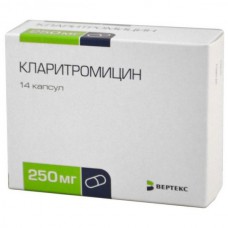Expiration date: 10/2026
Active substance
clarithromycin(clarithromycin)
Pharmacological group
Antibiotic of macrolides group
Product form, composition and packaging
Capsules
clarithromycin250 mg
7 PCs. - packaging sells contoured (2) - packs of cardboard.
14 PCs banks polymer (1) - packs of cardboard.
Registration??
caps. 250 mg: 14 PCs. - P ? 002496/01, 02.09.04
ATC code
J01FA09
Description the active component of the drug CLARITHROMYCIN
This scientific information is generalizing and can not be used to decide on the possibility of using a particular drug.
Pharmacological action:
Semi-synthetic antibiotic of the macrolide group. Inhibits protein synthesis in the microbial cell by interacting with the 50S ribosomal subunit of bacteria. Operates mainly bacteriostatic, but also bactericidal.
Active against gram-positive bacteria: Streptococcus spp., Staphylococcus spp., Listeria monocytogenes, Corynebacterium spp., gram-negative bacteria: Helicobacter pylori, Haemophilus influenzae, Haemophilus ducreyi, Moraxella catarrhalis, Bordetella pertussis, Neisseria gonorrhoeae, Neisseria meningitidis, Borrelia burgdorferi, anaerobic bacteria: Eubacterium spp., Peptococcus spp., Propionibacterium spp., Clostridium perfringens, Bacteroides melaninogenicus, intracellular micro-organisms: Legionella pneumophila, Chlamydia trachomatis, Chlamydophila pneumoniae, Ureaplasma urealyticum, Mycoplasma pneumoniae.
It is also active against Toxoplasma gondii, Mycobacterium spp. (except Mycobacterium tuberculosis).
Pharmacokinetics
The ingestion of clarithromycin is well absorbed from the gastrointestinal tract. Eating slows absorption, but does not affect the bioavailability of the active substance.
Clarithromycin penetrates well into biological fluids and tissues of the body, where it reaches a concentration of 10 times greater than in plasma.
Approximately 20% of the clarithromycin is immediately metabolized with the formation of the main metabolite 14-hidroclorotiazida.
At a dose of 250 mg T1 / 2 is 3-4 h, at a dose of 500 mg - 5-7 hours.
It is excreted in the urine unchanged and in the form of metabolites.
Indications for use of the drug
Treatment of infectious-inflammatory diseases caused by susceptible to clarithromycin activators: infections of the upper respiratory tract and ENT organs (tonsillopharyngitis, otitis media, acute sinusitis), infections of the lower respiratory tract (acute bronchitis, exacerbation of chronic bronchitis, community-acquired bacterial and atypical pneumonia), infections of skin and soft tissue mycobacterial infections (M. avium complex, M. kansasii, M. marinum, M. leprae) and their prevention in patients with AIDS, eradication of Helicobacter pylori in patients with duodenal ulcer or gastric ulcer (only as part of combination therapy).
Dosage regimen:
Individual. When ingestion for adults and children over 12 years old single dose of 0.25-1 g, the frequency of reception 2 times/day.
For children, the daily dose is 15 mg/kg / day in 2 admission.
The duration of treatment depends on the indications.
Patients with impaired renal function (CC less than 30 ml/min or serum creatinine level more than 3.3 mg/DL) dose should be reduced by 2 times or double the interval between meals.
Maximum daily dose: adults - 2 g, for children 1 year
Side effect
From the digestive system: nausea, vomiting, diarrhea, abdominal pain, stomatitis, glossitis, rarely - pseudomembranous colitis, in some cases - increased activity of liver enzymes, cholestatic jaundice.
From the Central nervous system: dizziness, confusion, fear, insomnia, nightmares.
Allergic reactions: urticaria, anaphylactic reactions, in some cases - Stevens-Johnson syndrome.
Other: temporary changes in taste.
Contraindications to the use of the drug
Severe impairment of liver function, hepatitis (in history), porphyria, I trimester of pregnancy, concurrent use with terfenadine, cisapride, astemizole, pimozide, hypersensitivity to clarithromycin and other macrolide antibiotics.
Pregnancy and lactation:
Use in the first trimester of pregnancy is contraindicated.
Application in the II and III trimesters of pregnancy is possible only in cases where the intended benefit to the mother exceeds the potential risk to the fetus.
If necessary, use during lactation should stop breastfeeding.
Special instruction:
Between antibiotics from the group of macrolides, cross-resistance is observed.
Treatment with antibiotics changes the normal flora of the intestine, so it is possible to develop superinfection caused by resistant microorganisms.
It should be borne in mind that severe persistent diarrhea may be due to the development of pseudomembranous colitis.
When coadministration with clarithromycin is recommended to monitor the concentration in plasma theophylline, carbamazepine, digoxin, lovastatina, simvastatin, triazolama, midazolam, fenitoina, cyclosporine, and ergot alkaloids.
Prothrombin time should be monitored periodically in patients receiving clarithromycin simultaneously with warfarin or other oral anticoagulants.
Use in Pediatrics
Currently, there is insufficient data on the efficacy and safety of clarithromycin in children under 6 months of age.
Drug interaction
Clarithromycin inhibits the activity of CYP3A4 isozyme, which leads to a slowdown in the metabolic rate of astemizole with their simultaneous application. As a result, there is an increase in the QT interval and increase the risk of ventricular arrhythmia type "pirouette".
While the use of atorvastatin moderately increases the concentration of atorvastatin in blood plasma, increases the risk of myopathy.
While the use of warfarin may increase anticoagulant warfarin and increase the risk of bleeding.
While the use of digoxin may significantly increase the concentration of digoxin in blood plasma and the risk of glycoside intoxication.
Believe that may increase the concentration of disopyramide in blood plasma by inhibiting its metabolism in the liver under the influence of clarithromycin. There is a risk of PROLONGATION of Qt interval, development of heart rhythm disorders such as "pirouette", increased insulin secretion and hypokalemia.
While the use of zidovudine decreases somewhat bioavailability of zidovudine, Itraconazole-significantly increases the concentration of Itraconazole in blood plasma, it is believed that there is a risk of increased side effects.
While the use of carbamazepine increases the concentration of carbamazepine in plasma, there is a risk of increasing its side effects, with colchicine-described cases of severe, life-threatening toxic reactions caused by the action of colchicine, lanzoprazole-possible glossitis, stomatitis and / or the appearance of dark coloration of the tongue, with methylprednisolone - decreases clearance of methylprednisolone, with midazolam - increases the concentration of midazolam in the blood and its effects increase.
While the use of omeprazole significantly increases the concentration of omeprazole and slightly increases the concentration of clarithromycin in plasma.
While the use of pimozide increases the concentration of pimozida in plasma, there is a risk of severe cardiotoxic action, with prednisone-described cases of acute mania and psychosis, ritonavir-possibly a significant increase in the concentration of clarithromycin, while the concentration of its metabolite 14-hydroxyclarithromycin is significantly reduced, rifabutin - increases the concentration of rifabutin in blood plasma, increases the risk of uveit, decreases the concentration of clarithromycin in plasma.
While the use of rifampicin significantly reduces the concentration of clarithromycin in the blood plasma, with sertraline-theoretically can not exclude the development of serotonin syndrome, with theophylline - may increase the concentration of theophylline in the blood plasma.
While the use of terfenadine may slow the metabolic rate of terfenadin and increase its concentration in blood plasma, which may lead to an increase in THE Qt interval and increase the risk of ventricular arrhythmia type "pirouette".
It is believed that while the use of tolbutamide, there is a possibility of hypoglycemia.
While the use of phenytoin may increase the concentration of phenytoin in blood plasma, the risk of toxic effects.
At simultaneous application with fluoxetine the case of development of the toxic effects caused by action of fluoxetine is described.
Inhibition of CYP3A4 isozyme activity under the influence of clarithromycin leads to a slowdown in the metabolic rate of cisapride with their simultaneous application. As a result, the concentration of cisapride in blood plasma increases and the risk of life-threatening cardiac arrhythmias, including ventricular arrhythmias such as "pirouette", increases.
While the use of cyclosporine increases the concentration of cyclosporine in blood plasma, there is a risk of side effects.
With simultaneous use of ergotamine, digidroergotamin described cases of increasing the side effects of ergotamine and digidroergotamin.


